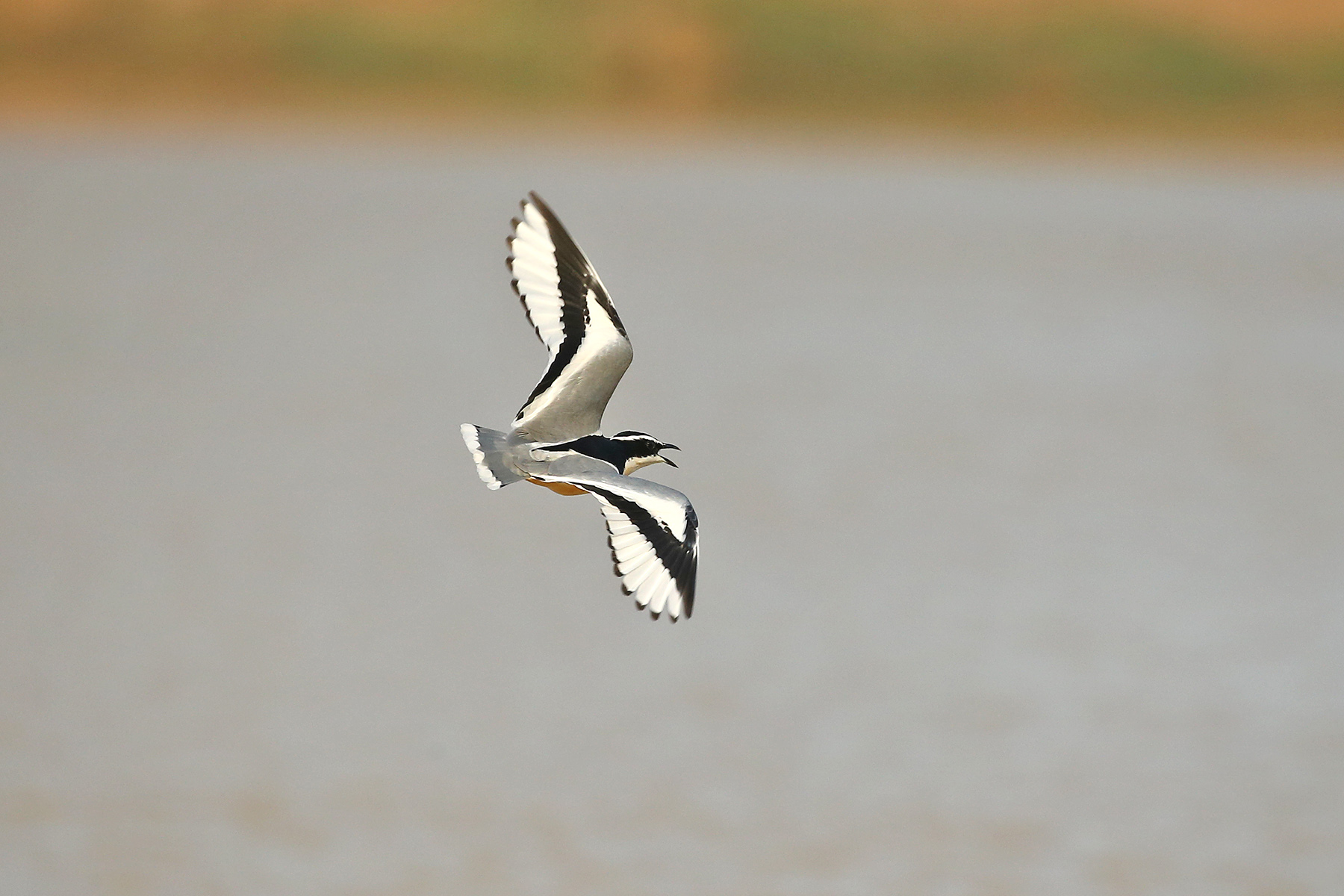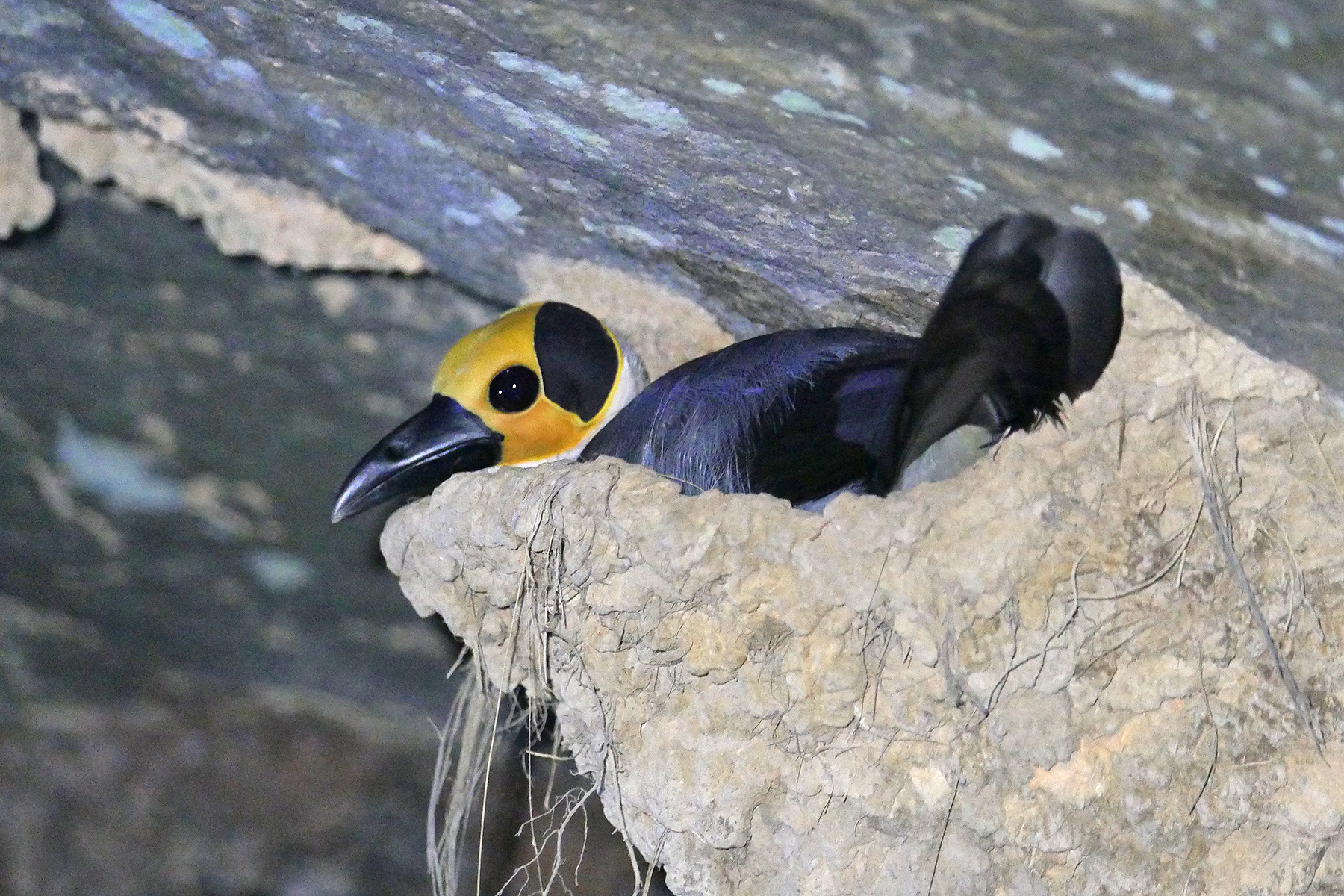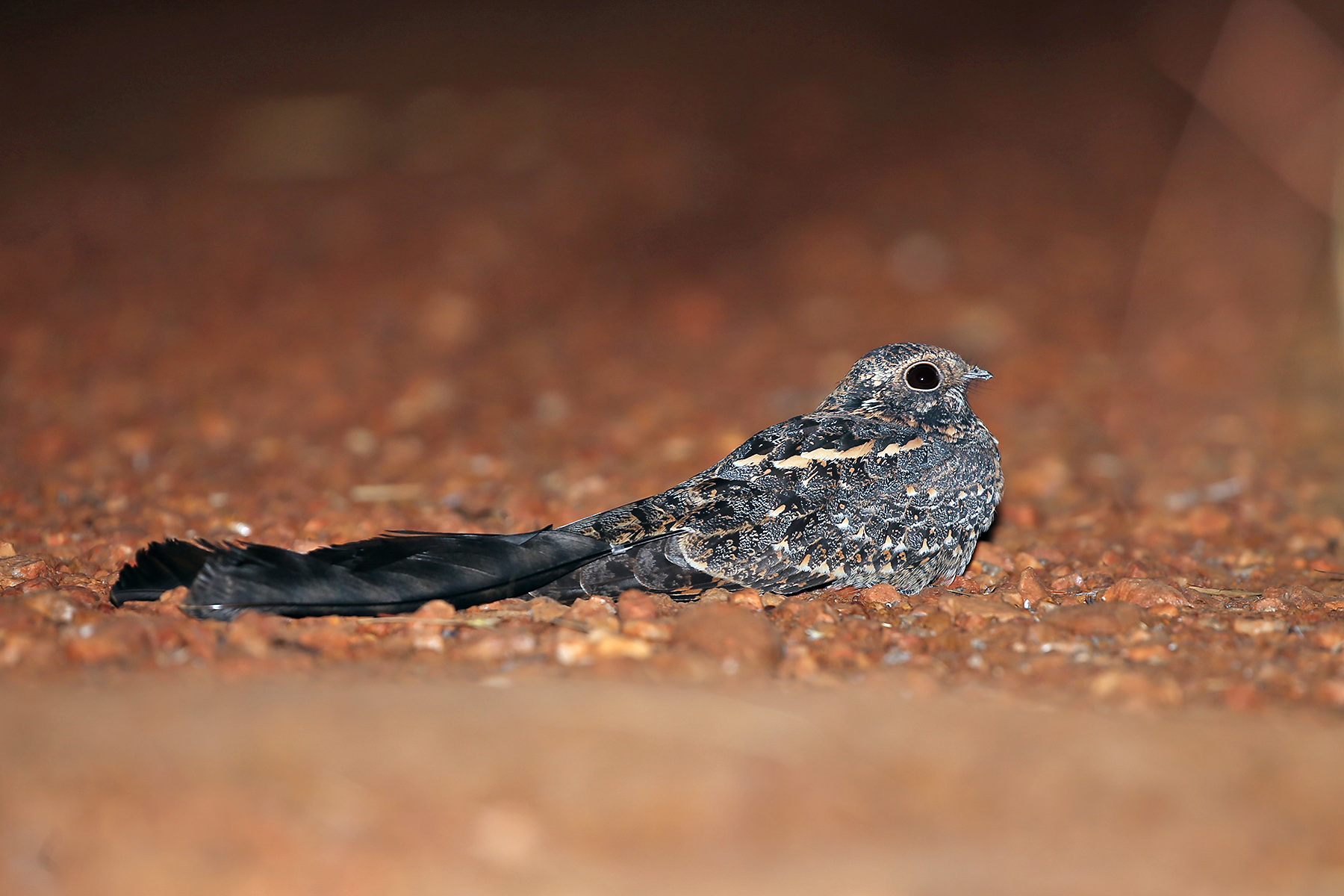BEST OF GHANA TOUR: DETAILED ITINERARY
Best of Ghana: Day 1 Our tour begins this evening in Accra, where we will stay overnight.
Best of Ghana: Day 2 This morning we will first drive a short distance northeast of Accra to the Shai Hills Resource Reserve. This is an area dominated by a chain of impressive inselbergs amongst dry thickets and sparsely wooded grassland. The invasive exotic Neem tree is being slowly cleared in order to return the habitat to its natural state.
This interesting forest/savanna transition zone holds a rather different avifauna to the forests that we will be experiencing elsewhere in the south. Stone Partridge and White-crowned Cliff Chat occur amongst the rocky outcrops, and Etchécopar’s Owlet (sometimes split from African Barred) can sometimes be found during the daytime. Puvel’s Illadopsis also occurs here and this will be our first chance to find one. The fascinating Oriole Warbler or Moho, the stunning Yellow-crowned Gonolek and both Guinea and Violet Turacos should be found, whilst Senegal Parrot and the striking Blue-bellied Roller provide further splashes of colour. Small bird parties include species such as Red-shouldered Cuckooshrike, Senegal Eremomela, Northern Crombec, White-shouldered Black Tit and Senegal Batis.
We shall also be on the lookout for Yellow-billed Kite, Hooded Vulture, African Cuckoo-Hawk, Shikra, Lizard Buzzard, Grey Kestrel, Ahanta and Double-spurred Francolins, Helmeted Guineafowl, Black-billed Wood Dove, Laughing, Red-eyed and Vinaceous Doves, Western Grey Plantain-eater, Senegal Coucal, African Palm and Little Swifts, Mottled Spinetail, Woodland and African Pygmy Kingfishers, Little Bee-eater, Broad-billed Roller, African Grey Hornbill, Yellow-fronted Tinkerbird, Vieillot’s and Double-toothed Barbets, Greater and Lesser Honeyguides, Rock Martin, Common Bulbul, Snowy-crowned Robin Chat, African Thrush, Singing, Short-winged and Zitting Cisticolas, Tawny-flanked Prinia, Grey-backed Camaroptera, Northern Black, Pale Flycatcher, Grey Tit-Flycatcher, African Paradise Flycatcher, Brown-throated Wattle-eye, Brown and Blackcap Babblers, Green-headed, Scarlet-chested, Copper and Splendid Sunbirds, Brown-crowned and Black-crowned Tchagras, Northern Puffback, Brubru, White-crested Helmetshrike, Fork-tailed Drongo, Pied Crow, Piapiac, Purple Starling, Northern Grey-headed Sparrow and Yellow-fronted Canary. Good numbers of Buffon’s Kob occur in the park and other regularly seen mammals include Olive Baboon and Callithrix Monkey.
Later we shall retrace our steps to Accra, pausing briefly at the Sakumono Lagoon where we shall hope to see a selection of lingering Palearctic waders and terns, as well as some widespread African waterbird species such as Long-tailed Cormorant, Striated (or Green-backed) Heron, Western Cattle, Black, Western Reef, Little, Intermediate and Great Egrets, White-faced Whistling Duck, African Jacana, Black-winged Stilt, Spur-winged Lapwing, Malachite and Pied Kingfishers, and African Pied Wagtail.
Once west of the traffic-clogged capital, the roads should be clearer and we will pay a late afternoon visit to the Winneba Plains. The remaining seasonally inundated grasslands here are home to species such as Black-winged Kite, African Hobby, Black-bellied Bustard, African Wattled Lapwing, Levaillant’s and African Cuckoos, Mosque Swallow, Flappet Lark, Yellow-throated Longclaw, African Moustached Warbler, Red-faced and Croaking Cisticolas, Red-winged Warbler, Northern Fiscal, Yellow-billed Shrike, Sulphur-breasted Bushshrike, Marsh Tchagra, Black-necked and Village Weavers, Vieillot’s Black Weaver (here of the distinctive form castaneofuscus, sometimes split as Chestnut-and-Black Weaver), Red-headed Quelea, African and Bar-breasted Firefinches, Black-rumped Waxbill, Quailfinch, Bronze Mannikin, Yellow-mantled Widowbird and Pin-tailed Whydah.
After a very full and productive day, we should arrive in the early evening at our lodge near Kakum National Park where we will stay for two nights.
Best of Ghana: Day 3 Kakum National Park is just a short distance north of our hotel. The park was created in 1932, but was not officially opened to the public until 1994. It covers an area of 347 square kilometres and protects a mixture of semi-deciduous and semi-evergreen rainforest, although this has been selectively logged in the recent past. The park is perhaps most famous as the site of Africa’s first and only rainforest canopy walkway, built in 1995, that is comprised of about 350 metres of bridge suspended between six tree platforms that reach the grand height of 40 metres above the forest floor! We will be allowed special access to the walkway before and after the official opening and closing times so that we shall have the platforms peacefully to ourselves.
As the dawn breaks a pair of Red-chested Goshawks can sometimes be seen circling overhead, our attention drawn by the repeated “chip” display call. Velvet-mantled Drongos use the wires of the walkway as convenient perches and the tree snags provide good lookouts for the Upper Guinea endemic Ussher’s Flycatcher, as well as Yellow-mantled Weaver and Red-headed Malimbe. Red-fronted (and rarely also Grey) Parrots screech overhead as they leave their roosts, Blue-throated Rollers and White-throated Bee-eaters adorn the treetops and Naked-faced and Bristle-nosed Barbets gather to feed in the fruiting trees. Forest and White-headed Wood-hoopoes inspect the epiphyte-bedecked boughs and Upper Guinea endemic Melancholy and Fire-bellied Woodpeckers drum on the bare trunks and branches. We shall be on the lookout for roving canopy bird parties that may include diminutive species such as the Upper Guinea endemic Sharpe’s Apalis, Rufous-crowned Eremomela, the pretty Violet-backed Hyliota, Lemon-bellied Crombec, the Upper Guinea endemic Kemp’s Longbill, Forest Penduline Tit and the tiny Tit-hylia. The much sought-after Congo Serpent Eagle and Long-tailed Hawk are regularly observed here, and it is fantastic to be on a level with canopy species that would normally be causing cricked necks as we stared upwards from terra firma! We can expect to find mouth-watering species such as Yellow-billed Turaco, Blue Cuckooshrike, Sabine’s Puffback and the gorgeous Upper Guinea endemic Buff-throated Sunbird. At this season Rosy Bee-eaters are non-breeding visitors and we will have our eyes to the skies in the hope of seeing them.
Other species to look out for include Palm-nut Vulture, African Harrier-Hawk, Black Sparrowhawk, Red-necked Buzzard, African Green Pigeon, African Emerald and Klaas’s Cuckoos (and with luck Thick-billed Cuckoo), Yellowbill (or Blue Malkoha), Sabine’s, Black and Cassin’s Spinetails, Bates’s Swift, White-crested, African Pied, Brown-cheeked, Black-casqued and Yellow-casqued Hornbills, Cassin’s Honeybird, Lesser Striped Swallow, the pretty Chestnut-capped Flycatcher, Blue-throated Brown, Little Green, Green, Collared and Superb Sunbirds, Yellow White-eye, Black-winged Oriole, Forest Chestnut-winged and Splendid Starlings, and Grey-headed, Chestnut-breasted and White-breasted Nigritas (or Negrofinches).
As the day warms up and more walkway visitors arrive, we shall move into the cooler interior of the forest and explore some of the trails that run through the park. In particular, we shall be looking for skulkers such as Upper Guinea endemic Grey-headed Bristlebill, White-tailed Alethe, Finsch’s Rufous Thrush and Western Forest Robin (the latter of the form inexpectatus, sometimes split as Ghana Forest Robin). We shall try hard to find a displaying Rufous-sided Broadbill, while a confusing array of greenbuls occurring here includes Little, Little Grey, Ansorge’s, Plain, Slender-billed, Yellow-whiskered, Golden, Honeyguide, Spotted, Icterine, White-throated, Western Bearded and Red-tailed Greenbuls, and Red-tailed Bristlebill. Other species here include Black Cuckoo, Buff-spotted Woodpecker, Grey Longbill, Green Crombec, Green Hylia, White-tailed Ant Thrush, Olivaceous Flycatcher, Blue-headed Crested Flycatcher, Red-bellied Paradise Flycatchers, West African Wattle-eye, Brown and Blackcap Illadopsises, Fraser’s, Olive and Olive-bellied Sunbirds, Shining Drongo, Blue-billed and Crested Malimbes, and Western Bluebill. Primates, which can be elusive, include Lesser Spot-nosed Monkey, Lowe’s Monkey and the rare Olive Colobus.
We shall take a mid-day break at our comfortable lodge and in the late afternoon, we shall return to the walkway and stay out until dark. We stand a reasonable chance of seeing the little-known Brown Nightjar and there is also a real possibility of Fraser’s Eagle-Owl. We may also hear other nocturnal species such as the strange-looking Nkulengu Rail and Latham’s Forest Francolin. Night mammals can be a hit-and-miss affair, but we shall look for Demidoff’s Galago, West African Potto and the stunning Pel’s Anomalure.
During our stay in the Kakum area, we will also visit an area of farmbush. The area has been cleared for cultivation and cocoa and is extremely degraded but nonetheless holds some interesting birds, including the beautiful Black Bee-eater. Piping Hornbills and the Upper Guinea endemic Copper-tailed Starling and Red-billed Helmetshrike are usually easy to see here. If we haven’t already done so, it is also a great place to see Speckled, Red-rumped and Yellow-throated Tinkerbirds.
Other species we may well see include Cassin’s Hawk-Eagle, Lanner Falcon, White-spotted Flufftail, Blue-spotted Wood Dove, Tambourine Dove, Didric (or Diederik) Cuckoo, Blue-headed Coucal, Chocolate-backed Kingfisher, Yellow-billed Barbet, Thick-billed Honeyguide, Purple-throated Cuckooshrike, Simple Leaflove, Swamp Palm Bulbul, Whistling Cisticola, Yellow-browed and Olive-green Camaropteras, Dusky-blue Flycatcher, Narrow-tailed Starling, Western Bluebill, Orange-cheeked Waxbill and Black-and-white Mannikin. Not too far away we will check out some rivers and streams where we should find a colony of Preuss’s Cliff Swallow, the glittering White-bibbed (or White-throated Blue) Swallow, Ethiopian Swallow, Rock Pratincole and White-headed Lapwing.
There are also reasonable chances here for the striking Yellow-throated Cuckoo, Black-billed Dwarf Hornbill, the diminutive African Piculet, the Upper Guinea endemic Little Green Woodpecker, Little Grey Flycatcher, Black-and-white Shrike-Flycatcher, West African Batis, Kemp’s Longbill, Red-vented Malimbe and Maxwell’s Black and Preuss’s Golden-backed Weavers. We shall also be on the lookout for the inexplicably localized Tessmann’s Flycatcher.
Best of Ghana: Day 4 After a final early morning session in Kakum, at a site where we stand a good chance of seeing Red-cheeked Wattle-eye, Puvel’s Illadopsis and Lowland Sooty Boubou, we shall drive further west, towards the border with Ivory Coast, to Ankasa Conservation Area for a three nights stay.
We will stop en-route to look for Mangrove and Reichenbach’s Sunbirds and Orange Weaver.
Best of Ghana: Days 5-6 Ankasa Conservation Area is an area of superb wet evergreen forest that only suffered relatively light logging between 1960 and 1974. The visit will certainly be worth our while for the high forest offers our best chance for some of the more elusive Upper Guinea Forest endemics and we will be making a special effort to find Yellow-bearded Greenbul, Green-tailed Bristlebill, Rufous-winged Illadopsis and Red-fronted Antpecker. African Finfoot is sometimes seen here and the little forest pools hold White-bellied and Shining-blue Kingfishers, Hartlaub’s Duck and occasionally White-crested Tiger Heron and Spot-breasted Ibis. At night, there is a fair chance of encountering Fraser’s and Akun Eagle-Owls, and African Wood Owl, and a slim chance for Sandy Scops Owl.
We shall bird inside the forest on narrow trails beneath the tall trees and cathedral-like stands of giant bamboo, as well as along the main track. Other species we can expect here include Black Crake, Blue-headed Wood Dove, Great Blue Turaco, Black-throated Coucal, Red-billed Dwarf Hornbill, Yellow-spotted and Hairy-breasted Barbets, Square-tailed Saw-wing, Western Nicator, Black-capped Apalis, Fraser’s Forest Flycatcher, Pale-breasted Illadopsis, Tiny and Johanna’s Sunbirds, and Western (Black-headed) Oriole.
Ankasa is a truly splendid forest tract and here, as well as looking for the species highlighted above, we also have catch-up chances for just about every West African forest bird species mentioned for other Ghana locations!
Best of Ghana: Day 7 After a final morning at Ankasa we shall return to Kakum for an overnight stay.
During the afternoon, we shall visit an area of coastal scrub where we have a good chance of seeing restricted-range Baumann’s Olive Greenbul and have a chance to catch up on anything we may have missed earlier at Winneba Plains. There could also be Compact Weavers and Yellow-crowned, Northern Red and Black-winged Red Bishops present but at this season they will all be in their non-breeding dress and hence difficult to identify.
Best of Ghana: Day 8 We will spend the morning further exploring Kakum National Park.
In the afternoon we will visit a site where Yellow-headed Picathartes (or White-necked Rockfowl) has been relatively recently rediscovered in Ghana. By contributing to a community-based project, we shall have special permission to visit the breeding site of this rarity, thus allowing us a marvellous and intimate opportunity to see this endangered species. Unlike many rockfowl sites, this one is easy to access. The rocks where the birds nest are about an hour’s uphill walk, initially through cultivation but then mainly along a narrow forest trail. Apart from a steep five minutes climb to the rocks themselves, this is a relatively easy walk by humid tropical forest standards. The birds are usually very obliging, being furtive rather than shy, and good views are sometimes quickly obtained however visitors should be prepared to have to sit and wait quietly for a long time, and the walk back may then be in darkness. The experience of seeing one of just two members of this extraordinary family will certainly be the trip highlight.
Afterwards, hopefully with everybody highly elated, we shall overnight at nearby Bonkro.
Ghana: Day 9 We will spend the morning in the forest around Bonkro. This is an area with some potential, over and above the fabulous Picathartes. Indeed, even the very rare Upper Guinea-endemic Western Wattled Cuckooshrike has been recorded here on a few occasions!
Ghana: Day 10 Today we will undertake the long drive north to Mole National Park for a four nights stay.
During the journey, we will watch the habitat change to broad-leaved Guinea Savanna woodland and the open plains that are typical of this region. We will make a few birding stops along the way.
We will arrive in the late afternoon and after dinner, we will search for the Standard-winged Nightjars that frequent the airstrip. Long-tailed Nightjar also occurs here and we will also be on the lookout for both Greyish Eagle-Owl and the delightful Northern White-faced Owl.
Best of Ghana: Days 11-13 At 4840 square kilometres (1869 square miles), Mole National Park is Ghana’s largest reserve and mainly consists of open Guinea Savanna woodland dissected by lushly vegetated riparian watercourses. There are also areas of open grassland and swamps in the floodplains and around waterholes. At least 314 species of birds have been recorded from the park as well as some 90 species of mammal that include African Savanna Elephant, Western Hartebeest, Roan Antelope, Red-flanked Duiker and even Lion.
A waterhole lies below our hotel, which is situated on a 250m (820ft) high escarpment offering breath-taking views over the park. The lure of water attracts many birds and mammals that need to quench their thirst in the dry heat and Exclamatory Paradise Whydahs are possible visitors. The pool is also home to Hamerkop, Woolly-necked and Saddle-billed Storks, Hadada Ibis, Greater Painted-snipe, Senegal Thick-knee and Grey-headed and Giant Kingfishers.
During our visit we will mainly explore the park on foot, taking guided walks with our armed park ranger. In this way, we hope to find Sun Lark, White-crowned Robin-Chat, White-fronted Black Chat, Rufous Cisticola and, if we are fortunate, White-throated Francolin, Forbes’s Plover and possibly even Rufous-rumped Lark.
As the day heats up so the conditions improve for raptor watching and we shall be on the lookout for African White-backed and White-headed Vultures, Dark Chanting and Gabar Goshawks, Bateleur, Beaudouin’s and Brown Snake Eagles, Wahlberg’s Eagle, African Hawk-Eagle, Grasshopper Buzzard and Red-necked Falcon.
A highlight of our visit to the Mole region will be an outing to the Volta River to an area frequented by the amazingly beautiful Egyptian Plover. This special bird is the sole member of its bird family and always a major highlight of visits to Ghana.
During our time in Mole we shall also be looking for such interesting species as Four-banded Sandgrouse, Bruce’s Green Pigeon, Red-headed Lovebird, Brown-necked Parrot, the gorgeous Northern Carmine and Red-throated Bee-eaters, Abyssinian Roller, Black Scimitarbill, Abyssinian Ground and Northern Red-billed Hornbills, Bearded Barbet, Red-chested and West African Swallows, the wonderful African Spotted Creeper, Pygmy Sunbird, Long-tailed Glossy Starling, Chestnut-crowned Sparrow-Weaver, Black-faced and Black-bellied Firefinches, Lavender Waxbill, Red-winged and Yellow-winged Pytilias, and Cabanis’s Bunting.
Species of wider distribution include Black-headed Heron, Spotted Thick-knee, Namaqua Dove, African Scops Owl, Pearl-spotted Owlet, Rufous-crowned Roller, Green Wood-hoopoe, Greater and Lesser Honeyguides, Eurasian Wryneck, Fine-spotted, Golden-tailed, Grey and Brown-backed Woodpeckers, Wire-tailed Swallow,
Yellow-breasted Apalis, Melodious Warbler, Yellow-bellied Hyliota, Pale, Swamp, European Pied and African Blue Flycatchers, Scarlet-chested and Beautiful Sunbirds, Woodchat Shrike, Brubru, African Golden Oriole, Square-tailed Drongo, Lesser Blue-eared Starling, Bush Petronia, Little, Heuglin’s and Red-headed Weavers, Black-bellied, Red-billed and Black-faced Firefinches, Red-billed Quelea, Red-winged Pytilia, and Brown-rumped and Cabanis’s Buntings.
Best of Ghana: Day 14 Today, after some final birding at Mole, we will retrace our steps back to Kumasi for an overnight stay. An evening visit to Bobiri may turn up an interesting nightbird. Nkulengu Rail, Fraser’s and Akun Eagle-Owls, and Brown Nightjar all occur here.
Best of Ghana: Day 15 This morning we shall visit Bobiri Butterfly Sanctuary. This site offers further chances for Afep and Western Bronze-naped Pigeons and there is a good chance for other forest species we may have missed up to now, such as Red-thighed Sparrowhawk, Black-throated Coucal, Red-chested Cuckoo, Forest Wood Hoopoe, Black Dwarf Hornbill, African Piculet, Willcocks’s Honeyguide and Grey-throated Flycatcher. Narina’s Trogon can often be found here and we could find a surprise or two. The spectacle of hundreds of colourful butterflies is quite something.
As the morning activity subsides we return to our hotel to wash and change, and take lunch, before heading back to Accra. Our tour ends in the evening at the airport.











































































































































